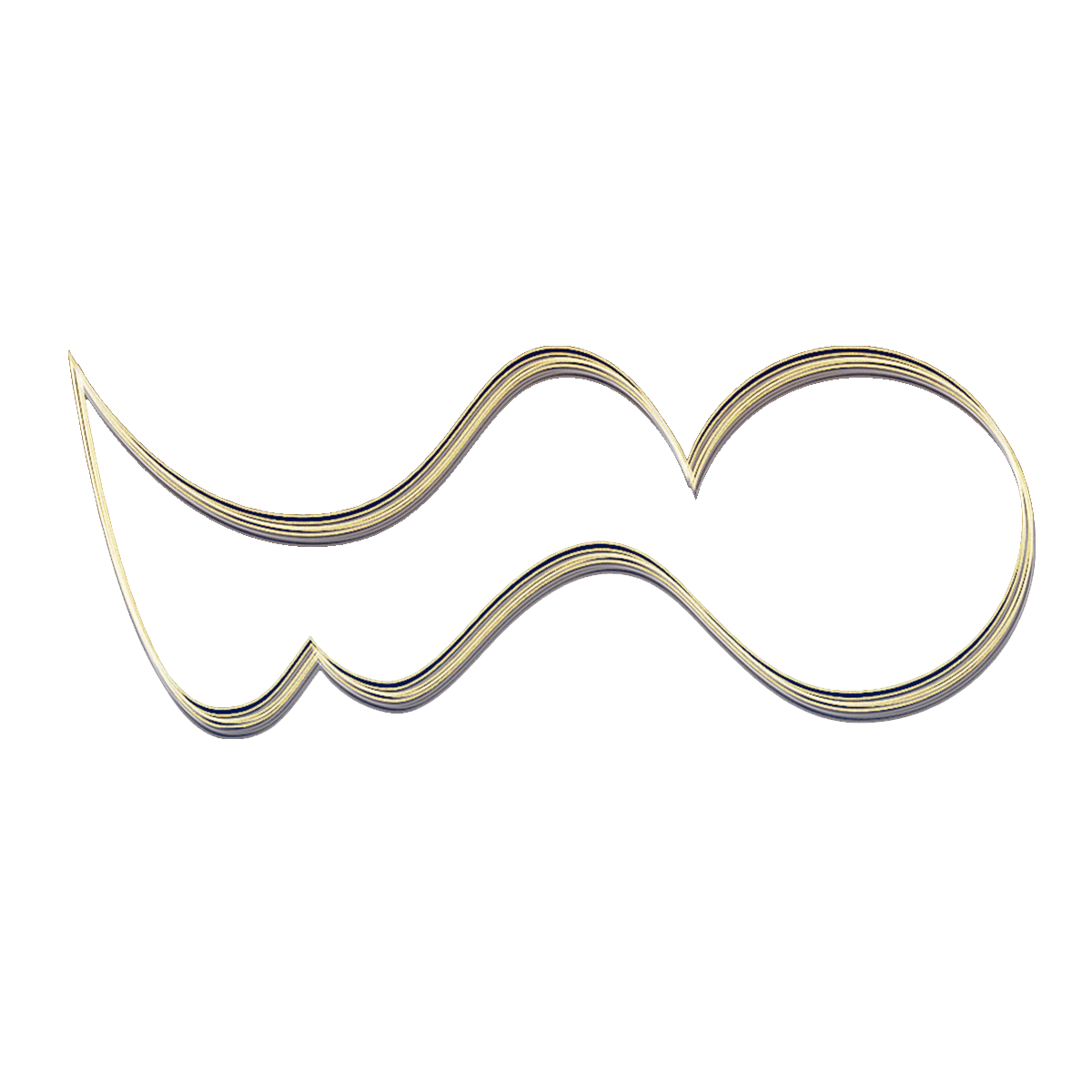Large Formats and Triptychs
The three Blues each measure 270 by 355cm, which would make them the artist’s first large formats if he had not already painted some large compositions to be featured in architectural projects. No doubt drawing on his experience in theatre set design from as early as 1926, Miró designed his first monumental painting for the pavilion of the Spanish Republic at the International Exposition of Arts and Techniques in 1937 (The Reaper, not conserved). In 1947, he received a commission for a long painting for the restaurant of a Cincinnati hotel (now in the Cincinnati Art Museum, Ohio). In 1950, he received a commission for another composition for a refectory at Harvard University (now in the Museum of Modern Art in New York).
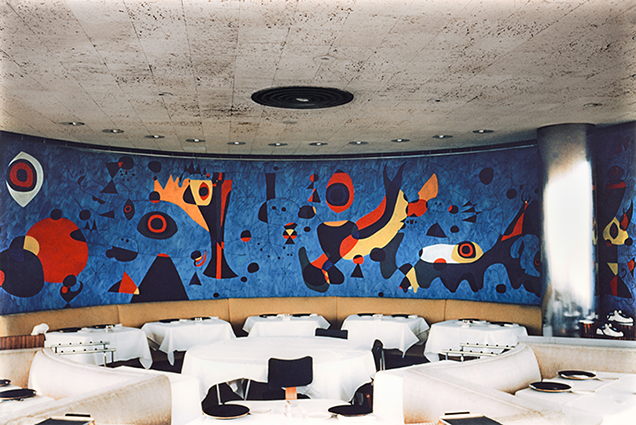
Miró’s stays in the United States to install these decors, and even more so his 1959 trip there, made him aware of the “new American painting.” Jackson Pollock, Arshile Gorky et Mark Rothko had themselves been influenced by Miró at the beginning of their careers and were regulars of the large format, thus pushing their elder to change scales. For Miró, liberating himself from the easel was also linked to a social awareness he had felt since the end of the 1930s, and a desire to paint for the greatest number.
With the three Blues, Miró adopted the triptych for the first time, a form that allowed him to follow his taste for narration. Miró would return to the format twice, with Painting on White Background for the Cell of a Recluse (1968) and Hope of a Condemned Man (1974). Now held by the Fundació Joan Miró in Barcelona, these triptychs are comparable in format to the three Blues. For each of them, painted with acrylic on a white background, Miró returned to a single line and, in the final triptych, opted merely for the simplest punctuations of colour, alternating blue, red and yellow.
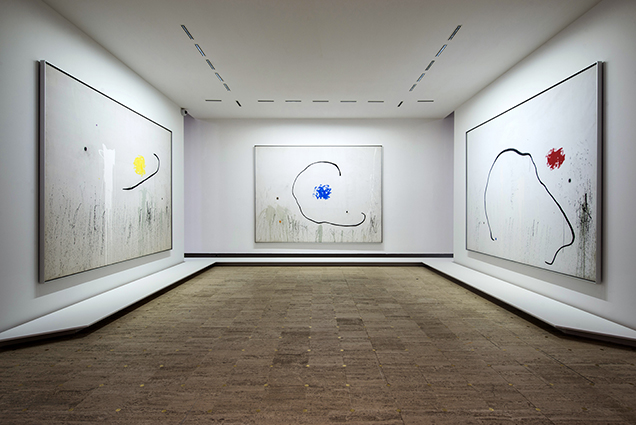
Miró on his Blues
It took me a long time to make them. Not to paint them, but to meditate them. It meant an enormous effort on my part, a very great inner tension, to attain the spareness I wanted. The preliminary stage was an intellectual order… like the celebration before a religious ritual, yes, like taking holy orders. You know how Japanese archers prepare for competitions?
They begin by getting themselves into the right state – exhaling, inhaling, exhaling – it was the same for me. I began by drawing them in charcoal, very precisely. (I always start work very early in the morning). In the afternoon, I would simply look at what I had drawn. For the rest of the day, I would prepare myself internally. And finally, I began to paint: first the background, entirely blue, but it was not simply a matter of applying colour, like a house painter: all the movements of the brush, my wrist, the breathing of my hand – all these things also came into play. ‘Perfecting’ the background put me in the right state to go on with the rest. This struggle exhausted me. I have not painted anything since. These canvases are the culmination of everything I have tried to do up to then.” (in Rosamond Bernier, ‘Propos de Joan Miró’, L’Œil, n° 79-80, July-August 1961, p. 18)
The First Exhibitions
As was often the case with his recent works, Miró wanted Paris to be the first to see his Blues. Without waiting, it was to the Galerie Maeght at 13 Rue de Téhéran that he entrusted them to be shown to the public. Entitled “Miró. Mural Paintings”, this exhibition was held from 23 June to 31 July 1961.
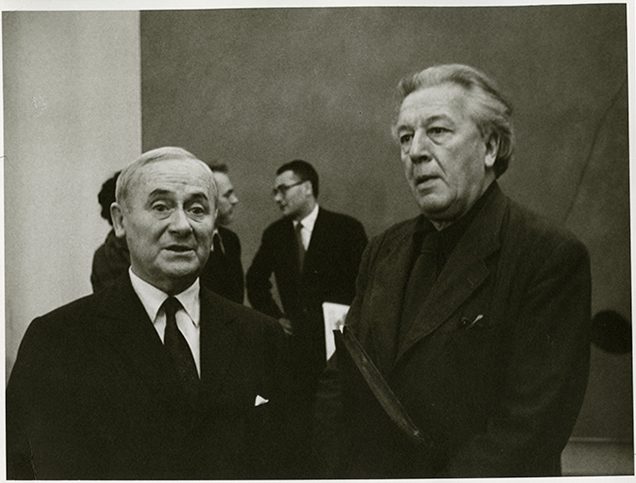
The gallery was one of the most important in Paris at the time and had been created by Aimé Maeght who had given Miró a contract in 1945, thus taking over from his historic dealer in Paris, Pierre Loeb.
In the autumn, the three Blues crossed the Atlantic to be presented at the Pierre Matisse Gallery on the corner of Madison Avenue and 57th Street from 31 October to 25 November 1961. Under the simple title “Miró. 1959-1961”, the exhibition was accompanied by an album featuring superb lithographs.
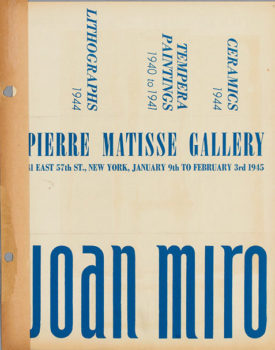
Pierre Matisse was the youngest son of Henri Matisse and had inaugurated his gallery in 1931. He had exhibited Miró back in 1932 and had signed a contract with him two years later, that was to prove decisive in getting his work known in the United States.
It was not until 1968 that there would be another opportunity to see the three paintings together, first at the Fondation Maeght in Saint-Paul, then in Barcelona in the same year, followed by Munich in 1969, before other exhibitions.
However, the three paintings were soon to go their separate ways. While the penultimate owners of Blue I and Blue II were to be French fashion designer Hubert de Givenchy and the Franco-American couple Dominique (née Schlumberger) and Jean de Menil, Blue III was to remain the property of the Pierre Matisse Gallery.
Si la page ne se ferme pas, merci de cliquer sur la croix dans l’onglet de votre navigateur.

Reproduced Works and resources
- Joan Miró (1893-1983), Mural for the Terrace Plaza Hotel, Cincinnati, 1947, oil on canvas, Cincinnati Art Museum, Commissioned for the Gourmet Restaurant at the Terrace Plaza Hotel, inv: 1965.514© Successió Miró / Adagp, Paris 2020 © photo Cincinnati Art Museum
- Photo of the exhibition , with L’Espoir d’un condamné à mort I, II, III in the retrospective organised by the national galleries of the Grand Palais, Paris. 3 october 2018 – 4 february 2019. © Successió Miró / Adagp, Paris 2020 © photo Didier Plowy
- Miró retouching Bleu II in the Maeght gallery, June 1961. Print. Kandinsky Library, Joan Miró collection © All rights reserved © photo Bibliothèque Kandinsky, MNAM/CCI, Centre Pompidou – Dist. RMN-Grand Palais
- Joan Miró and André Breton , inauguration of the “Miró. Mural Paintings” exhibition at the Galerie Maeght, June 1961. Print. Kandinsky Library, Joan Miró collection © All rights reserved © photo Bibliothèque Kandinsky, MNAM/CCI, Centre Pompidou – Dist. RMN-Grand Palais
- Invitation card for an exhibition of Joan Miró at the Pierre Matisse Gallery, NYC, Jan-Feb 1945. ScrapBook d’André Breton [1944-1945].ScrapBook. Kandinsky Library, André Breton collection© Adagp, Paris 2020 © Photo © Bibliothèque Kandinsky, MNAM/CCI, Centre Pompidou – Dist. RMN-Grand Palais / BRET 2.26
